You can't build a strong language foundation without dedicating time to all four of the basic skills — reading, writing, speaking and listening. But some of these skills are admittedly more challenging to practice on your own. In my opinion, the hardest to practice is listening comprehension. Japanese is among the fastest spoken languages in the world, and finding content that's suited to your level without feeling intimidating can be daunting. Luckily, the wide array of podcasts for Japanese learners have made this process a little bit easier.
JapanesePod101.com is one such podcast for Japanese language learners with a truly massive archive. Since it launched in 2005, they have created an entire ecosystem of language-learning podcasts and videos, a website with language tools, practice exercises, and more; all available via subscription on a number of different platforms. With the back catalog, there's a little something for everyone, though navigating the library can be confusing.
What sets JapanesePod101.com apart from the competition is the format. Rather than just informal chatting, episodes of JapanesePod101.com are structured like textbook lessons, with a scripted dialogue, vocabulary, grammar points, and more. However, unlike other textbook audio resources, JapanesePod101.com isn't an all-in-one solution to studying like the marketing makes it seem, and is best suited as an audio supplement to an already-established plan of study. Additionally, with three different subscription tiers called "Basic," "Premium," and "Premium PLUS," all with slightly different features, and the constant push to upgrade, even picking the right plan can be confusing.
In this article, I'll talk about the structure of the courses and the lessons themselves, the hosts and voice actors, as well as the bonus content and features available on their website so you can decide if JapanesePod101.com is right for you.
- What is JapanesePod101.com?
- How the Episodes are Organized
- A Typical Episode
- Varying Hosts and Actors
- Bonus Content
- Site Tools
- The Bad: Confusing Organization and Price Structure
- Conclusion
What is JapanesePod101.com?
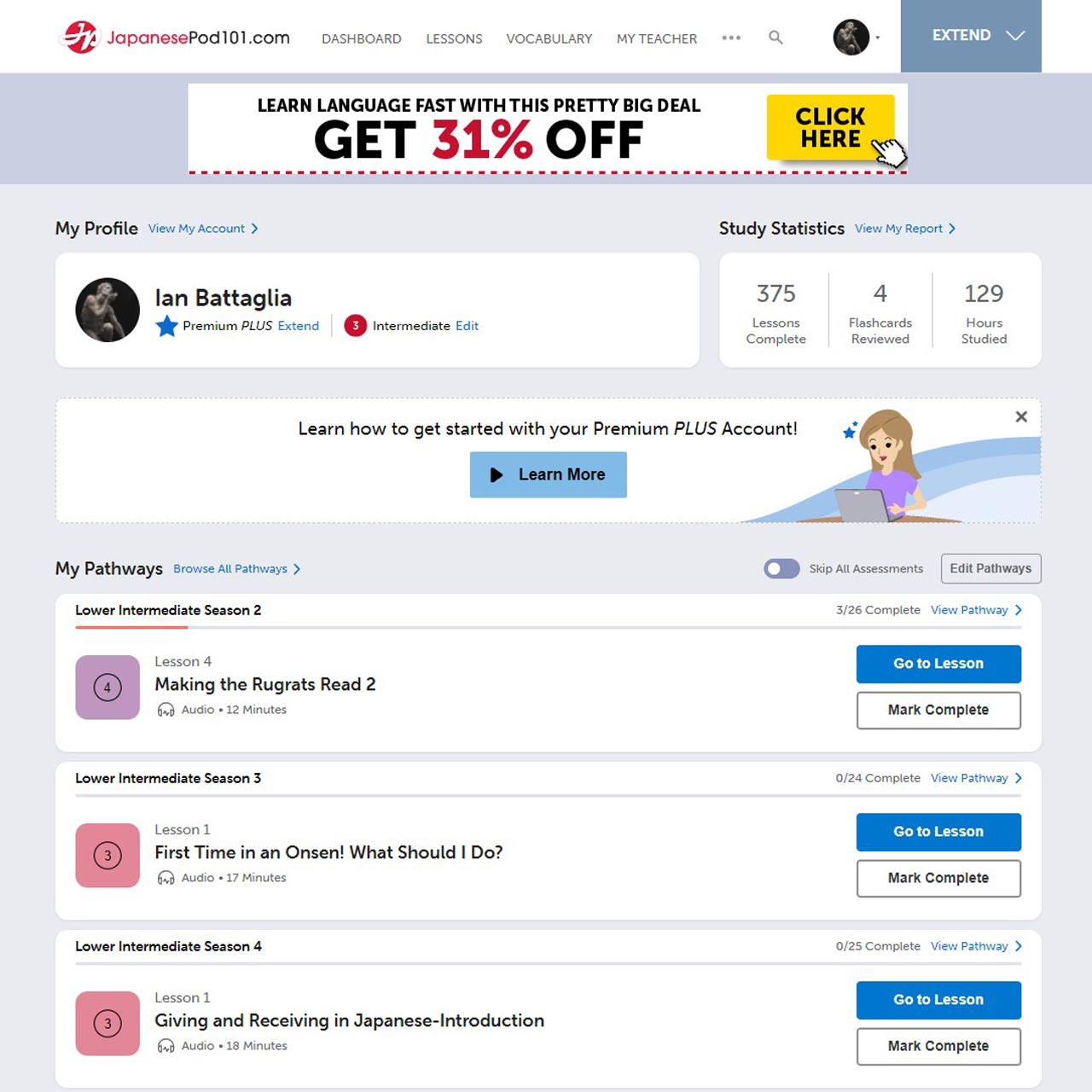
JapanesePod101.com is a Japanese language learning podcast that since its launch in 2005 has grown to not only hundreds of hours of audio content, but videos, and a range of other language-learning tools available on their website. Through a parent company, they've also branched out into dozens of other languages and have continued to grow and refine the product. In 2017 they restructured all their lessons, new streamlined lesson plans were released back in 2019, and in 2020 they added a new voice recording tool to the website.
JapanesePod101.com was founded on the idea that speaking lies at the heart of any language. With this in mind, they use the podcast format to offer listening comprehension and speaking practice through call-and-response sections that encourage you to repeat phrases aloud, and a voice recording tool on their website.
While the content on their site is wide-ranging, in this article I'll be concentrating on the podcasts that are the namesake and main focus of JapanesePod101.com.
How the Episodes are Organized
Continuously publishing new content for over fifteen years has led to a ton of episodes, but it's not always so easy to find what you're looking for. Let's take a look at how the episodes are organized so you don't get lost!
Lessons are grouped into five difficulty levels ranging from "Absolute Beginner," which caters towards JLPT N5 learners, up to "Advanced," which is suited for N2 learners. Certain series, particularly the main ones such as "Lower Intermediate," are often broken down further into different "seasons." There are also series that cover more specialized topics such as 四字熟語 or yojijukugo, four-character idioms.
I've said it before, but it bears repeating: the library is massive. Most seasons are hours long. For example, getting through all six seasons of the "Lower Intermediate" series will take you over forty hours to complete.
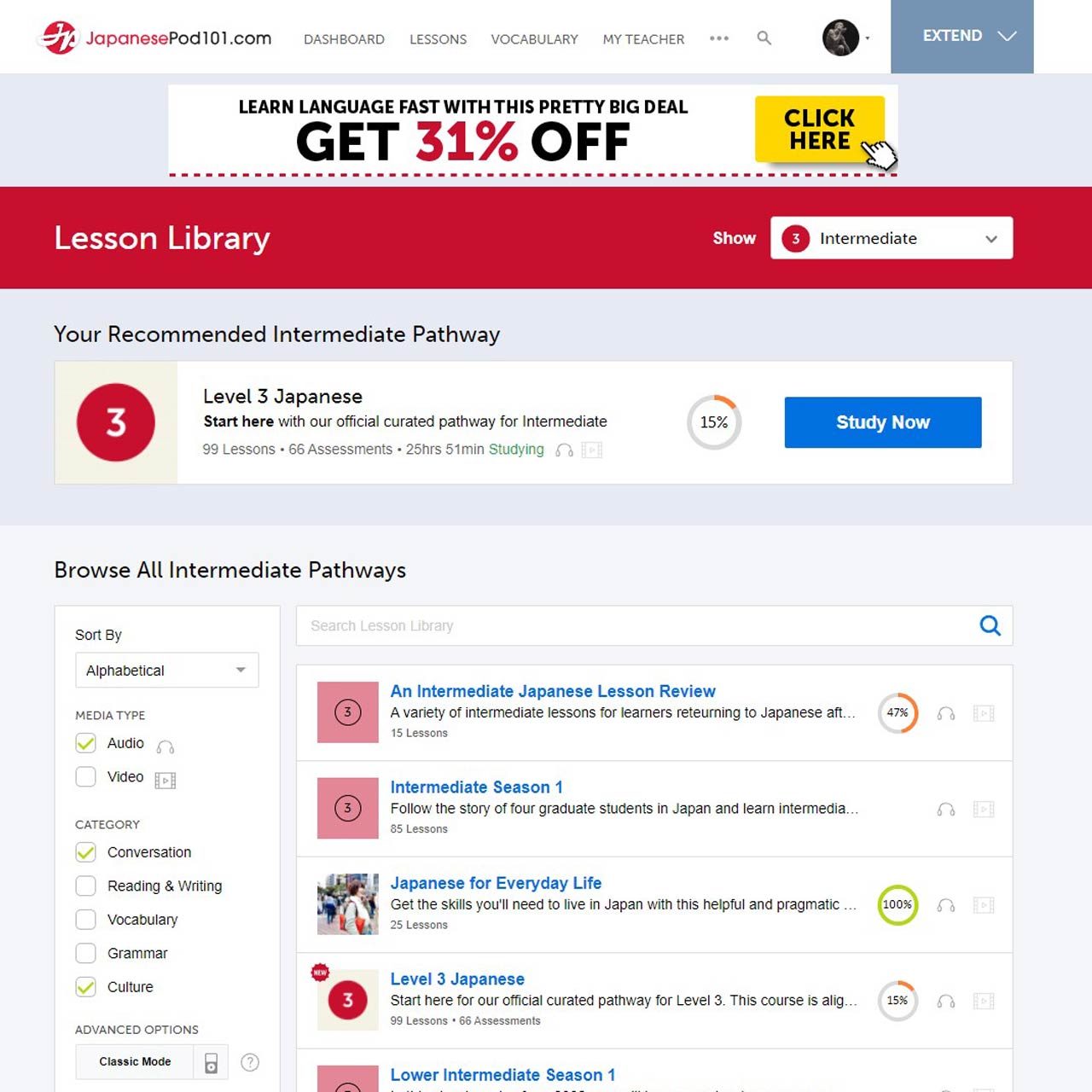
Through the website and the app you can sort lessons alphabetically, by most recent, or by most popular; or filter to show only audio, only video; or bring up episodes that are a mix of categories such as conversation, reading and writing, vocabulary, grammar, and even culture. Additionally, there's the "classic" mode button, which shows lessons organized according to their original list order before the 2017 reorganization — more on that soon! It's honestly a bit confusing, but you don't need to worry about it too much. I'll talk about this later, but most learners will be just fine jumping right into their new curated pathway tailored to your level. You'll find them featured on the top of the page as "Your Recommended Pathway."
While the filtering controls are good, they're not perfect. For example, I'd love to be able to filter or search for episodes with specific hosts, as the host plays a big part in the quality of the episode. Also, most series are tagged with the same categories, so filtering doesn't really help narrow down your choices. Finally, there's no option to filter by production date — aside from sorting by recent, and the classic mode toggle — and many of the earliest series are starting to show their age.
You May Run Into the Same Content (Over and Over)
As I mentioned earlier, despite the format of JapanesePod101.com's episodes matching a textbook, it's not quite as complete or direct a learning method. One example of this is how topics don't quite cumulatively build on one another, but instead tend to be repeated, either with overlapping or identical topics, or episodes repeating in different playlists.
Since lessons can appear in multiple playlists, clicking on a lesson will show you which playlists the episode belongs to, like a series of tags. For example, an episode called "Who is That Japanese Person?" which focuses on noun-modifying clauses, also known as relative clauses, is part of "Level 3 Japanese," the curated pathway for the Intermediate level, as well as "JLPT N4 Recommended Course," "Lower Intermediate Series, Season 6," and "The Path to Advanced Japanese," among others. Noun-modifying clauses is a pretty common concept, and you'll likely run into this same episode over and over in different places on JapanesePod101.com.
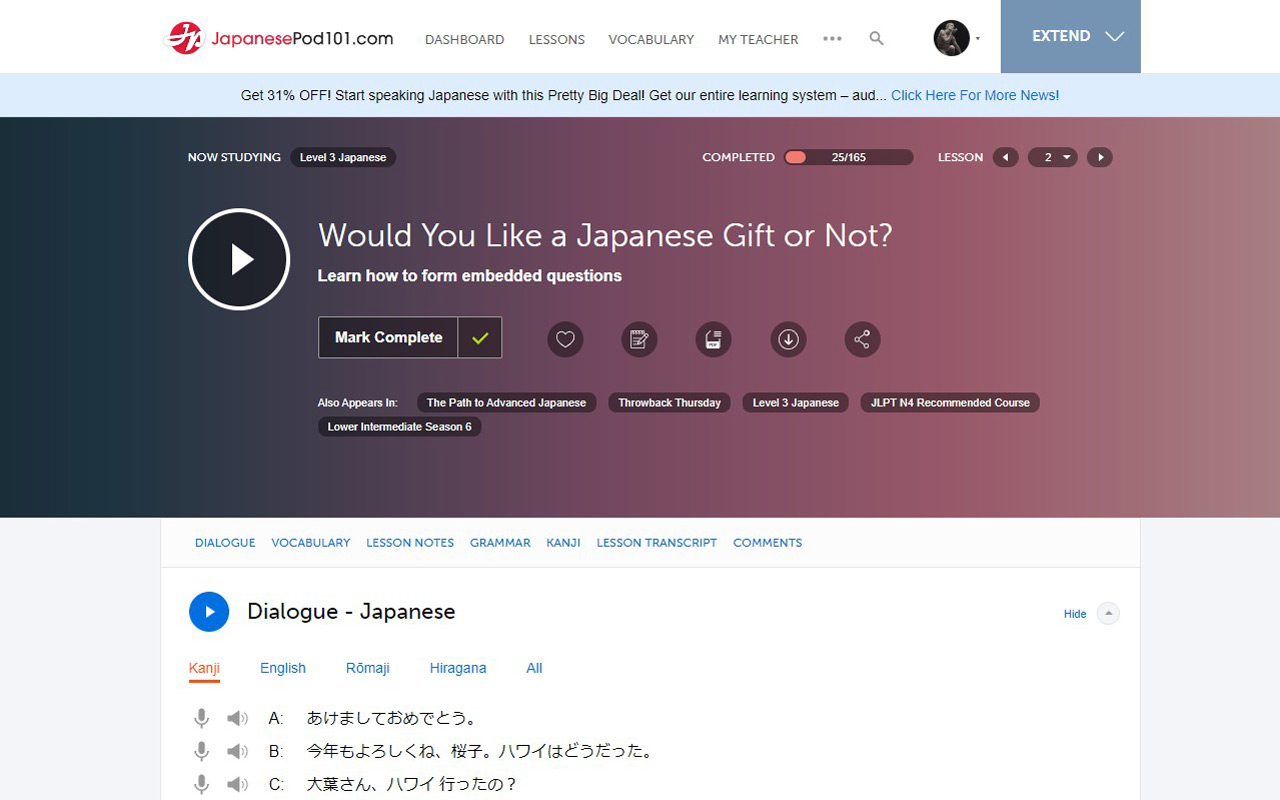
Beyond lessons appearing in multiple places, different series will sometimes cover the same grammar points. This is an intentional feature rather than an oversight, as it's meant to help reinforce your understanding, or deepen it through added nuance, however it's something to note. JapanesePod101.com doesn't have the linear structure of a language textbook that's meant to build on the knowledge of previous lessons. Sometimes the lessons in a series do build on one-another, but the same concepts might be covered in other series later on. Additionally, the focus is on beginner to intermediate-level Japanese learners, which contributes to the repetitiveness. JapanesePod101.com is not a textbook replacement, but more of a massive library of supplementary audio content. As long as you're clear about what you're signing up for, it can be a valuable resource.
Reorganization and New Pathways
JapanesePod101.com has a reputation for being difficult to navigate, a charge they're well aware of. Over the past few years, they've made strides to correct this, reorganizing all the lessons, and then creating new curated pathways for their "Absolute Beginner" through "Advanced" levels.
These new learning pathways are not simply new playlists, but instead are redesigned and thoughtful courses, with quizzes and assignments for anyone in the premium subscription tier or above. By nature, podcasts are typically meant to take in rather than being interactive, meaning they're all about input and don't necessarily prompt any output. Without any means to put what you've been learning into practice, it's hard to gauge how effective the process is. By adding a formal method for evaluation, JapanesePod101.com puts the power in the hands of the learner to evaluate any weak points and reinforce what you need to review. Their tutoring service, which I'll talk about in a later section, reflects the same aim at autonomy.
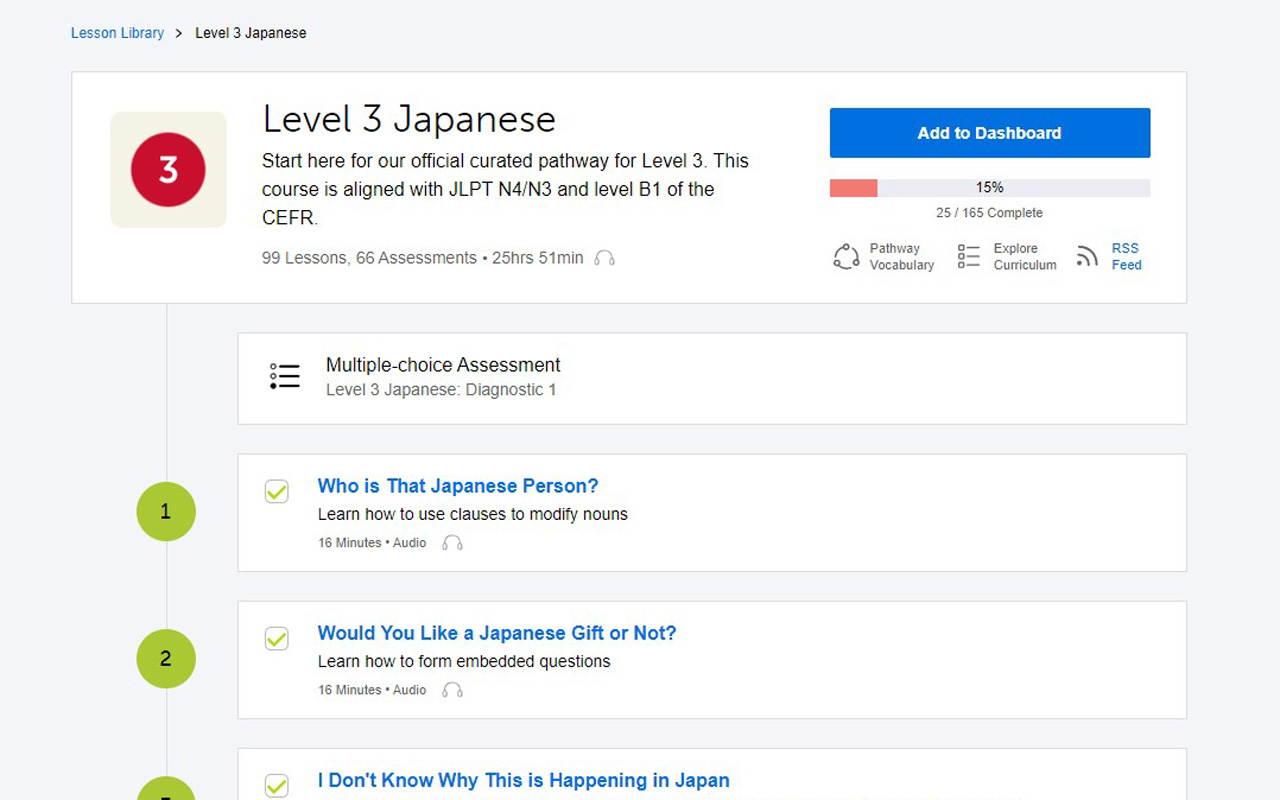
For most students, both newcomers and veterans of JapanesePod101.com, rather than the old playlists, these new pathways like "Level 3 Japanese" are going to be what you want. If you stumble upon a lesson or topic in a series that you'd like to explore further, you can check out other related series for a deeper dive.
You'll find these new pathways featured as "Your Recommended Pathway" at the top of the Lesson Library page, so make sure to choose this unless you're looking for a deep-dive on a specific topic on JapanesePod101.com.
A Typical Episode
Now that we've talked a bit about how the site is organized, let's take a look at what a typical JapanesePod101.com lesson is like. While there are some lessons with more specific aims, in general they follow a similar format, and all tend to be around 15-20 minutes long, which makes it easy to find time to slot them into your day.
Like I mentioned, this is quite a different format from most of the popular Japanese language learning podcasts. In my experience, podcasts tend to focus on immersion, with native speakers chatting or following a script they've written. Sometimes, they limit the grammar or vocabulary they use to make listening easier for beginner Japanese learners. JapanesePod101.com, on the other hand, is much closer to the sort of lesson you might find in a beginner textbook like Genki — with a carefully structured pedagogy covering a scripted dialogue, then introducing vocabulary, and finally grammar.
1. Introduction
Episodes open with the hosts giving the title of the episode, and establishing the scenario for the dialogue that follows. They explain not only the situation, but how many speakers there will be and who they are, as well as the formality level of the Japanese spoken. This is helpful, as instead of trying to spend the first bit simply parsing who the speakers are and what the situation is, you can focus on what's being said and the language used.
2. Dialogue
Next is the dialogue itself, performed by actors rather than the hosts. These should be familiar to students who worked through a textbook series such as Genki, though of course in JapanesePod101.com, the main focus is on the audio (a copy of the script and some notes are also included, both on the website and on the app; more on this later). The dialogues tend to be a bit over-dramatic in an attempt to be goofy, but the audio quality is really clear, and I'm not embarrassed to say they've made me chuckle from time to time. The dialogue is played at natural speed first, and then with an English translation following each line. Some of the lower-level series also include a version with slower Japanese, if you're having trouble understanding the full-speed version, but the higher-level series leave this out.
3. Dialogue Discussion
After this, the hosts return for a bit of a chat about the dialogue, giving listeners even more listening practice. While hosts will occasionally offer an English translation for a vocabulary word here and there, this is generally all in Japanese, so you have to be on your game to follow along.
4. Vocabulary
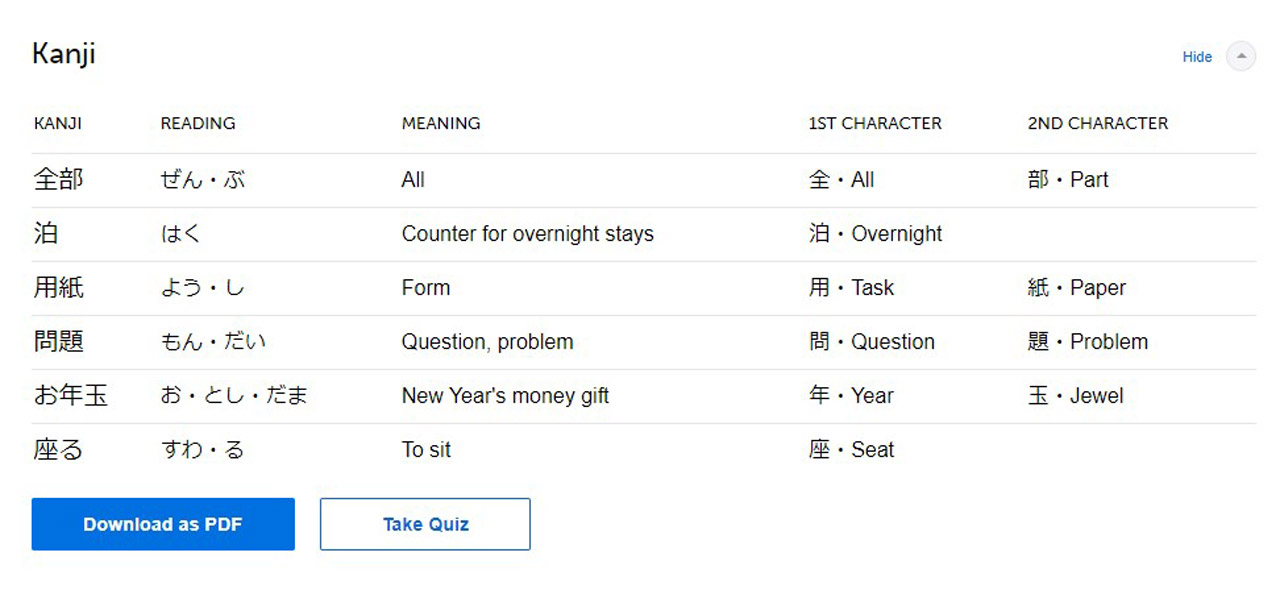
Next, they go over the vocabulary. They pick keywords from the dialogue, provide the reading, a definition or two, and often even cover pitch accent. They go beyond just reading a simple list, however. After the overview, they jump into a more in-depth look, which might cover how the word is used, or how it's differentiated from similar words.
5. Grammar
Next, the hosts move into grammar. Each lesson aims to cover a distinct grammar point, from something as broad as the causative form, to a single specific expression. They give examples from the dialogue as well as new examples to illustrate nuance. While the explanations aren't quite as in-depth as something like A Dictionary of Japanese Grammar, they're more than enough to give you an understanding of the usage across a few scenarios. The hosts also tend to ask each other impromptu questions, providing even more detail.
6. Wrap-Up
Finally, there's a bit of a wrap-up section, where the hosts might joke around or chat a bit more before playing the dialogue one more time. I really appreciate this aspect, as having gone over all the vocabulary and grammar can make it even more comprehensible the second time around, which in turn makes it much better study material.
It might sound a little boring having most episodes follow this general format, but I think the consistency makes it more effective studying, and that's what makes JapanesePod101.com special.
Varying Hosts and Actors
Now that you know a bit about how most episodes flow, let's talk about who you'll be listening to. JapanesePod101.com has a wide pool of hosts and actors, and each season has a couple of dedicated hosts that appear in every episode. So while every episode of Lower Intermediate Season 6 will have the same hosts, they're not necessarily the same hosts from the rest of Lower Intermediate. While everyone on staff speaks Japanese, series tend to have at least two hosts, with one being a native English speaker, and one being a native Japanese speaker playing the role of the teacher. Some of the native Japanese speakers only speak limited English, which is great for practice, but that also means leaning on the English speaker to help clarify some of the more confusing points.
The native English-speaking staff also vary in their Japanese ability. Everyone does a good job communicating, but occasionally an accent can make comprehension a bit difficult, like the Scottish Kat, or New Yorker Peter (who frequently jokes about the quality of his Japanese speech). Other English-native hosts, like Chris, communicate so effectively in Japanese that it lifts the quality of the whole episode.
You'll likely develop your own personal preferences for who you like listening to the most.
Even so, there's a wide variance, and like anything else you'll likely develop your own personal preferences for who you like listening to the most. This can be a good or a bad thing, as sometimes an episode or series you want to listen to has a host you might not like. Likewise, with the new learning pathways, the hosts change very frequently depending on where the episodes were pulled from — this way, you're rarely stuck with anyone you don't prefer, but you can't quite settle into the host's rapport as well.
Personally, I grew to really like listening to Naomi, one of the native Japanese speakers who acts as teacher and host for many of the episodes. She does a great job explaining concepts and writes most of the dialogues, so she can explain some of her reasoning or provide more nuance if need be.
The dialogue actors manage to keep things entertaining yet easy to understand.
The dialogue actors also manage to keep things entertaining yet easy to understand. Like I mentioned earlier, the script writing and performance tends toward goofy or over-dramatic rather than too serious, but if anything the heightened emotion can make the narrative easier to comprehend. Some series have narratives that continue across the entire season, or at least recurring characters. Actors change roles between series though, so someone who might've been an exchange student in one season could become a teacher in the next.
The dialogues aren't limited to the voice acting, either. They might have sound effects or background audio when applicable, which makes them sound a bit more natural than just something read in a sterile studio. The goofy or cheesy tone might be a bit of an adjustment compared to the more straight-laced tone of the Genki dialogues, for example, but once you get used to it, I think you'll have few complaints with the audio.
Bonus Content
Of course, JapanesePod101.com isn't only audio. There's a wide range of different PDFs, from full transcripts to isolated explanations of the grammar covered in an episode, which you can access on both the app and website. Over the years JapanesePod101.com has added a number of new tools and resources to the site, such as flashcards, and even a tutoring service. Let's take a look at what features JapanesePod101.com offers beyond the audio episodes.
Full Transcripts and Grammar Explanations
Each episode also has accompanying text either embedded on the website or PDF download available on the website or the app. The dialogue is transcribed, and on the website you can play each line individually, or practice speaking with the voice recorder tool if your subscription allows. Similarly, vocabulary is listed with check-boxes that let you add words to a "wordbank" for further review (again, depending on your subscription tier).
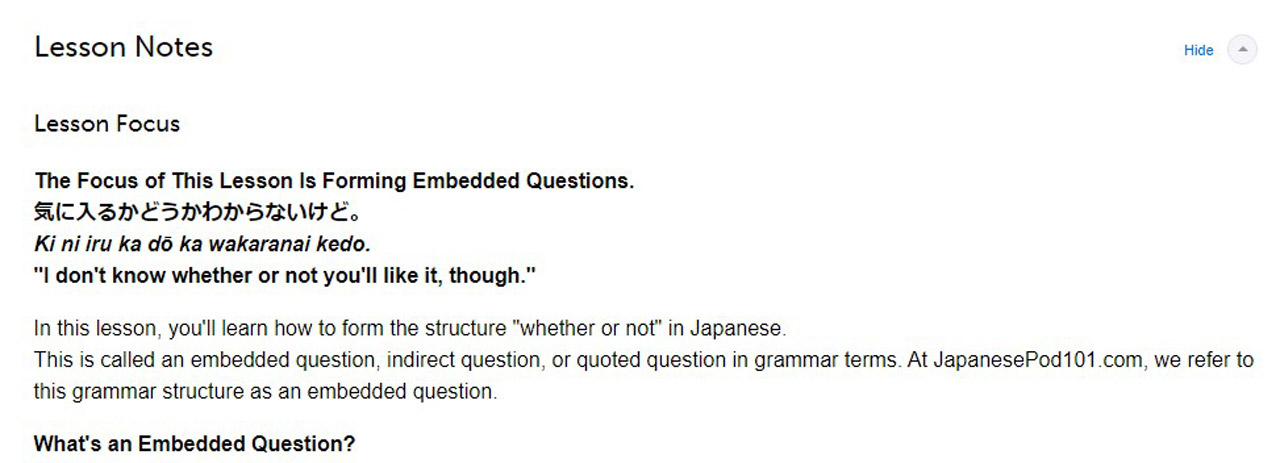
Next is the grammar explanation, which is again very similar to a textbook format. They explain a grammar point, list sentences from the dialogue and outside examples, and break down elements like conjugation, particles, or use. There's also a list of references, so you can refer back to previous episodes for a more detailed review of certain concepts.
Finally, there's a full transcript of the episode that extends even to the hosts' chatting, should you want to follow along. I found this to be a great way to review the more natural, unscripted Japanese as the hosts are speaking offhand, or to confirm what I'd heard. While the focus is clearly on the audio, having everything available in writing to follow along with concurrently is a huge benefit. Beyond this, the completely unique grammar write-up separate from the grammar explanation in the episode or transcript makes JapanesePod101.com a very comprehensive resource.
Videos
In addition to audio and text, JapanesePod101.com also has a large video catalog. In addition to what's available on their website (filterable and categorized in their own series), there's also a substantial YouTube channel, which I wrote about for our Japanese Grammar YouTube Channels for Beginners article.
These videos cover a lot of different topics, from culture, to detailed grammar explanations, to simple vocabulary lists. The quality is usually high, with excellent graphics that complement live-action recordings. Unfortunately, the videos feel like something of an afterthought. They're not included in any of the revised pathways from what I can tell, which might tell you a bit about their superfluous nature. While they're nice to have, and some of the cultural videos can be especially interesting, it's really more of an add-in than a major part of the experience.
Site Tools
Depending on your subscription tier, there are a number of tools on the website to make JapanesePod101.com more of an interactive learning experience. I like the concept behind many of these tools — finding ways to increase participation in podcasts, which are usually more of a passive learning method. However, while it's a worth aim, many of the tools have notable downsides, so read on before you spring for one of the higher-tier subscription plans.
Audio Recorder
First and foremost is the line-by-line audio and audio recorder, which you'll hear the hosts promote on many episodes. This allows you to play back individual lines from the dialogue, as well as record your own voice repeating those lines to check against. This is a fairly straightforward feature, and works well. However, as the dialogues tend to be dramatic or goofy, JapanesePod101.com doesn't always make the best shadowing material in my book. If you just practice mimicking what you hear, you'd probably end up sounding pretty weird. Instead, it can be a good resource primarily for practicing reading aloud.
Wordbank and Flashcards
Then there's the wordbank. This is simply a list of words you've selected from the vocabulary from various lessons. You can sort them into different groups, and they're listed with their reading, an audio reading of the file, and a definition, but no context from the sentences in the dialogue, and not much else you can do with them aside from sending them to JapanesePod101.com's flashcard system. This might be useful if you wanted to simply to look through every once and a while as a refresher, but I didn't end up using it much.
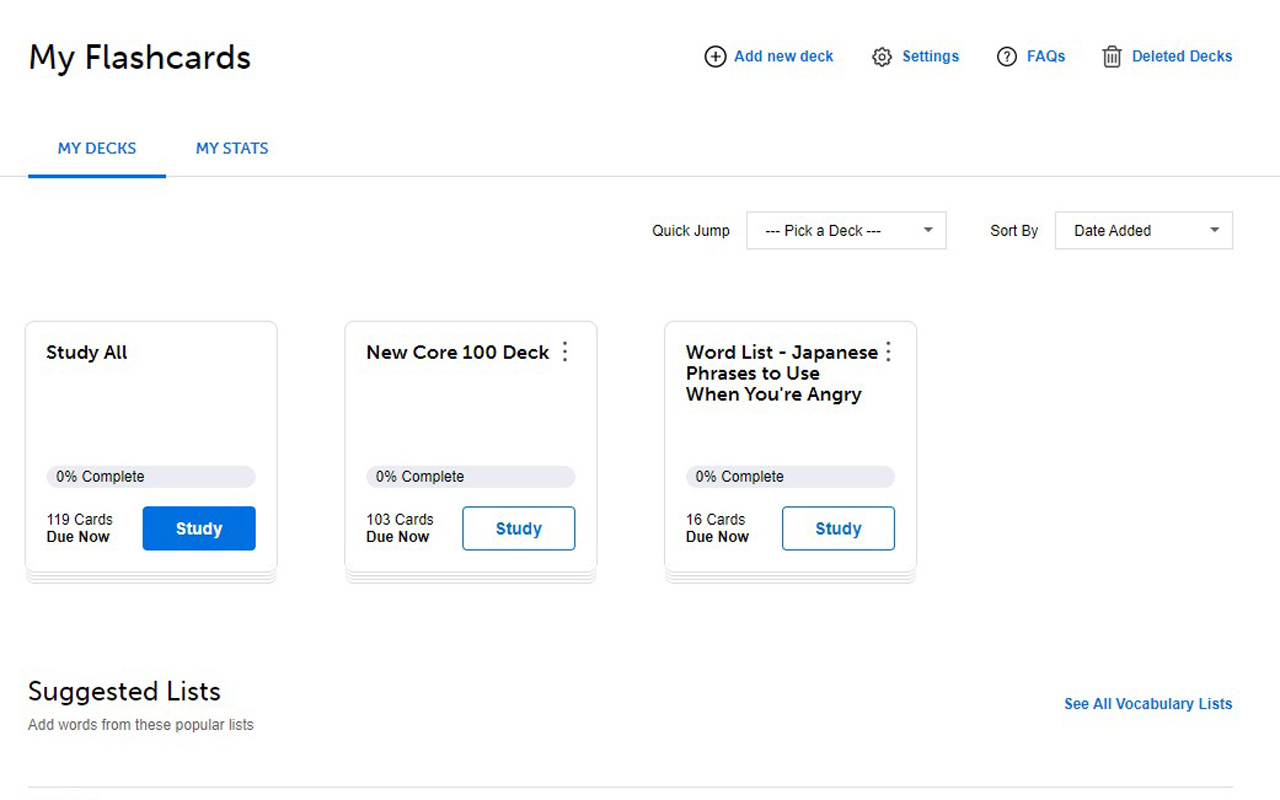
Speaking of flashcards, let's talk about their flashcard system. JapanesePod101.com has a huge list of different flashcard decks you can study from. They range from themed decks like "Japanese Phrases to Use When You're Angry," to custom lists from a dictionary or your wordbank, to frequency lists such as the most common 100 or 2000 Japanese words.
Really, the flashcards are a very similar system to many other flashcard apps. It's nice that they're all set, so you don't have to mess around with formatting or settings, and they all include audio from what I can tell. Of course, there's a lot less flexibility with something like this compared to another system like Anki, with only a "Correct" or "Incorrect" button to adjust how long until you're shown the flashcard again. Additionally, the flashcards only seem to be available on the website, and not through the app, which makes reviewing them a lot more limited. If you'd like to drill flashcards, and are willing to deal with the limitations in exchange for the ease of use, this might be a good option for you.
Quizzes
There are also quizzes to put what you've been learning to the test in a way unlike any other language podcast. Some quizzes are part of their integrated tutoring service, which I'll talk more about in the next section. This is a great addition, as without something to check your progress, I think it would be easy to convince yourself you've learned a topic covered simply because you've listened and understood a lesson. This way, you can make sure you fill in any potential gaps.
Tutoring
All the way in the highest tier, Premium Plus, JapanesePod101.com offers its biggest feature: My Teacher, which promises personal tutoring to suit your schedule. However, like much of JapanesePod101.com, the reality isn't quite as rosy as the marketing.
The "My Teacher" feature is the purpose of the Premium Plus subscription tier, and once you sign up, you're given access to a level-assessment test to help personalize your experience. The test is pretty quick, with a few questions in different categories that cover various language domains, such as vocabulary, grammar, reading, listening, and writing. It took me about a half hour to complete, at which point I was given an immediate grade based on my results, with a confirmed grade via email checked by a teacher.
Personal tutoring is conducted via a text messaging page where a teacher provides feedback and corrections.
After this, you're assigned a teacher, and sent a PDF outlining how JapanesePod101.com intends for this feature to work. As you might have been able to tell, this teaching experience isn't quite the same as a lesson over Zoom. Instead, the majority of the experience is conducted via a text messaging page where you can send text, audio, videos, and pictures to a teacher, who will provide feedback and corrections based on your conversations, similar to the corrections done in a language exchange app like HelloTalk.
The intent here is that the teacher can provide an even more personalized recommendation on relevant podcast episodes and videos from the JapanesePod101.com archive, and then supplement your learning with assessments (often quizzes similar to the sort you might find in an app like Duolingo), individual assignments (like the first assignment you're given upon signing up, being asked to write and record a self-introduction), and answering your questions on the fly as they come up.
There's a lot of value in finding a teacher to help with your studies, but I wouldn't recommend this particular service.
As I mentioned in my HelloTalk review, I think it's nice to be able to get corrections and ask questions from a teacher you can trust, but without any sort of formal one-on-one lesson, it's only useful to an extent. Really, half the experience seems to be sort of a concierge to the JapanesePod101.com program. And with the price ranging between $23 a month all the way up to $47 a month based on how long you subscribe, I think your money is best spent elsewhere.
I do believe there's a lot of value in finding a teacher to help with your studies, but I wouldn't recommend this particular service. Instead, check out my article on finding a Japanese teacher for some other options.
The Bad: Confusing Organization and Price Structure
While JapanesePod101.com has a lot to offer Japanese learners, it's not all roses. I think the first problem users will encounter is that it's complicated. There's just a huge number of episodes and series, and even with the revised pathways it's easy to get lost. The website doesn't offer much in the way of guidance either, with the connection between components like the episodes themselves, the wordbank, and the flashcards a bit obtuse.
Even the subscription plans are confusing, and in a way that feels intentionally misleading. Users are encouraged to upgrade their subscription tier at seemingly every turn, and prices vary based on the duration of your subscription. For example, the highest tier subscription, Premium PLUS (which offers the tutoring service), is listed as $23 a month, but only if you sign up for a two-year plan. Beyond this it jumps all the way up to $47 a month for a monthly plan. You really have to know what it is you want to purchase and how long you intend to use it, otherwise it's easy to make a mistake.
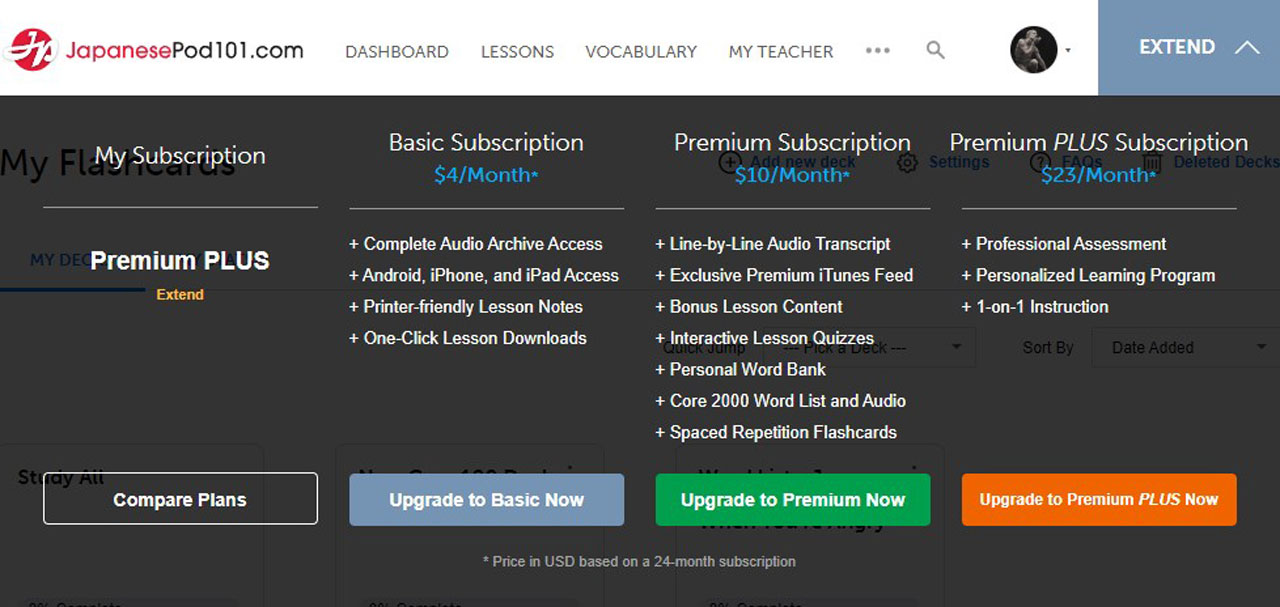
Even simply signing up for an account on the website is a challenge, with multiple prompts to upgrade your account before you even get a chance to try it out. Their aggressive marketing approach on top of this confusing pricing structure can feel underhanded, and is a big turn-off for me.
Additionally, most of the added features unlocked in the higher tiers really don't add much to the experience or aid you in the learning process any more than listen-in lessons. Aside from perhaps prompting you to be more diligent in your studies, JapanesePod101.com is not the all-in-one Japanese learning resource they make it out to be, and really not a textbook replacement either. Instead, it's a vast library of high-quality audio lessons, with some notable limitations.
Conclusion
Overall, JapanesePod101.com is a good resource, but it's not the one-stop-shop it makes itself out to be. I think for a certain type of student, one who's already studying from a primary textbook under the guidance of a teacher, it's a great supplemental resource, though you have to know what you're looking for and how you intend to use it. Having said that, JapanesePod101.com stands apart from many other Japanese language-learning podcasts, working more like a textbook in audio form, albeit an extremely long one. JapanesePod101.com's best content is pretty good, but a lot of it doesn't maintain a high standard.
Personally, I've enjoyed listening to JapanesePod101.com in times when it would be otherwise difficult to study, such as while walking my dog, doing my laundry, or going for a run, and in situations where I want to work on my listening comprehension without having to focus as intently as I do while immersing. For this, I think the basic plan (which is $6 a month or less, depending on how long you pay in advance) should cover most students. The next tier gets you tools like quizzes, the voice recorder, and flashcards, and the final tier adds tutoring, but I think for most students that money is best spent elsewhere. At $6/month, you're getting access to a truly huge library of audio content; in fact, if anything, too much.
Ian’s Review
JapanesePod101.com has a lot to offer the Japanese learner, but the experience is marred by a lot of bloat and confusion. For learners with some spare time in their day looking for a huge library of grammar lessons available anywhere, there’s a lot of value to be had, but unfortunately very little of the additional content is worth your money. Still, it’s found a place as part of my study habits, and something I come back to from time to time. If you’re the type of student that JapanesePod101.com is suited for, I think you’ll enjoy it; just don’t expect to become fluent through it alone.
